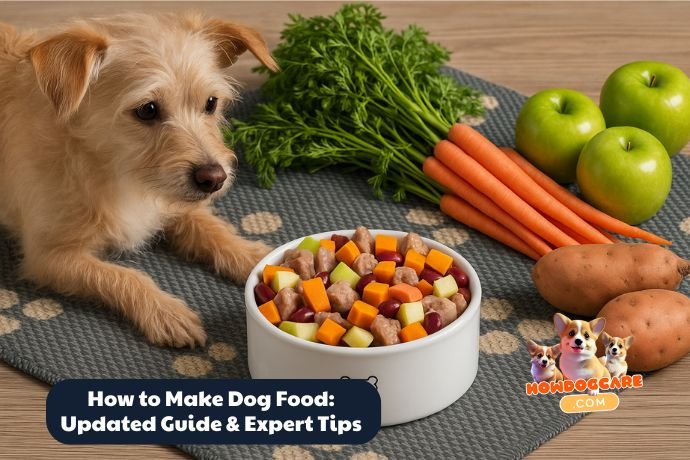Why Make Dog Food? Pros, Cons & Myths
Homemade feeding is popular for three big reasons: control, freshness, and palatability. When you Make Dog Food at home, you can choose lean cuts, visible vegetables, and simple starches your dog digests well. Many owners report better appetite, smaller/steadier stools, and shinier coats—largely because you’re serving moisture-rich food with named ingredients and minimal additives. You also gain transparency: no mystery “meat by-products,” and you decide where ingredients come from. That matters for dogs with sensitivities—single-protein recipes and limited ingredients make it easier to identify what agrees with your pup.
There are trade-offs. The #1 risk when people Make Dog Food is nutrient imbalance—especially calcium, iodine, zinc, copper, selenium, vitamin D, and E. Meat + rice alone is not complete. Over time, missing micronutrients can cause brittle bones, anemia, skin issues, or worse. Time and food safety are the other hurdles: you’ll prep, cook, cool, portion, and store correctly to avoid spoilage. Cost can be higher than budget kibble, though smart shopping and batch cooking help.
Three myths to retire:
- “If it’s healthy for me, it’s healthy for my dog.” Nope. Dogs have different needs and toxicities (grapes/raisins, onions/garlic, xylitol).
- “Calcium from bones in broth is enough.” Not even close. You need measured calcium (powdered eggshell or calcium carbonate/citrate) to match phosphorus from meat.
- “A multivitamin makes any recipe complete.” Multivitamins are general; dogs need canine-specific mineral targets. Use vet-formulated recipes or reputable DIY supplement kits designed for complete diets.
Bottom line: You can safely Make Dog Food—and see real benefits—if you follow vetted recipes, add the right supplements, and treat kitchen hygiene like a pro.
Nutrition 101: What Dogs Need Before You Make Dog Food
Think of a balanced bowl as calories + macro quality + micronutrient coverage. Most adult dogs do well around protein 20–35% of calories, fat 10–25%, and the remainder from digestible carbs/fiber—ranges shift by activity, age, and health. Practical rule: choose high-quality protein first (chicken, turkey, beef, pork, eggs, fish), then a gentle starch (rice, oats, potatoes, sweet potatoes, quinoa), add non-starchy veg (carrots, spinach, green beans, pumpkin), and healthy fats (fish oil for EPA/DHA; a touch of olive/canola for energy).
Micros are where most DIY attempts fail. Key points before you Make Dog Food:
- Calcium:Phosphorus ≈ 1.1–1.5:1. Meat is phosphorus-heavy; add calcium precisely (typically ~900–1,000 mg Ca per 1 lb cooked meat, but follow your recipe’s exact dose).
- Iodine (thyroid), zinc/copper/selenium (skin/immune), vitamin D & E (bone/antioxidant), B-complex—these require a canine-specific supplement blend or a tested recipe that hits AAFCO/NRC targets.
- Life stage: Puppies and pregnant/lactating dogs have higher calorie and mineral needs; large-breed puppies require careful calcium and energy control. If you plan to Make Dog Food for these groups, use veterinary nutritionist recipes only.
Frameworks: AAFCO sets pet-food nutrient profiles; NRC publishes detailed recommended allowances. You don’t have to memorize tables—but you must use a formula that was built to meet them. That’s why reputable DIY kits (with exact recipes + supplement blends) are a smart on-ramp.
Safety First: Foods to Avoid, Hygiene & Storage
Before you Make Dog Food, print this no-go list: grapes/raisins, onions, garlic, chives, leeks, xylitol (in sugar-free gum/candy/peanut butter), chocolate/cocoa, macadamia nuts, alcohol, uncooked bread dough, excessive salt, nutmeg, caffeine. Avoid cooked bones (they splinter), very fatty trimmings, and excessive liver (vitamin A toxicity risk). If in doubt, leave it out and check with your vet.
Hygiene makes or breaks homemade feeding. Set up a clean prep zone: separate cutting boards for meat and veg, wash hands/utensils with hot soapy water, and keep raw meats cold. Cook poultry and ground meats to 165°F (74°C); whole-muscle beef/pork to safe temps as advised. After cooking, cool rapidly: spread food in shallow pans, refrigerate within 60 minutes, then portion once chilled. Storage rules when you Make Dog Food:
- Fridge (≤4°C / 40°F): up to 3–4 days sealed.
- Freezer (≤-18°C / 0°F): 2–3 months for best quality; label recipe + date + calories per portion.
- Thaw in the fridge (overnight) or in a sealed bag in cool water; never on the counter.
- Reheat gently to room temp or slightly warm; don’t cook added vitamin/mineral blends unless your recipe says it’s heat-stable.
These basics let you Make Dog Food that’s not only nutritious but safe.
✅ Related Articles
- Best Dog Food for Chihuahuas | Top 10 Reviews & Expert Guide
- Best Dog Strollers 2026 | Top 10 Reviews, & Expert Buying Guide
- Top 10 Best Dog First Aid Kits (2026): Trail, Travel & Home
Core Formula: A Balanced Template to Make Dog Food
A practical starting template many balanced recipes echo (by cooked weights):
- 60–70% lean animal protein (e.g., 90–93% lean ground turkey/chicken/beef; include 5–10% organ like liver/heart within this total).
- 10–20% cooked starch (white/brown rice, oats, potatoes, sweet potatoes, quinoa).
- 10–20% low-oxalate vegetables (carrots, green beans, zucchini, spinach/kale in modest amounts, pumpkin).
- Added fats as needed (1–2 tsp per 1,000 kcal) to hit energy targets.
- Supplements: precise calcium, EPA/DHA fish oil, and a canine multi-mineral designed for homemade diets.
Do not omit supplements. When you Make Dog Food, the supplements are what transform a tasty recipe into a complete one.
Starter Recipe 1: Turkey & Rice (≈ 1,800 kcal total)

- 900 g (2 lb) 93% lean ground turkey, cooked and drained
- 300 g cooked white rice
- 200 g finely chopped carrots + green beans (lightly steamed)
- 15 g olive or canola oil
- Calcium per recipe label (e.g., finely ground eggshell powder ~1 tsp ≈ 1,800–2,000 mg Ca; or calcium carbonate as directed)
- Fish oil to deliver ~50–100 mg EPA+DHA per kg body weight/day (split across portions)
- Canine vitamin/mineral blend (follow label for batch size)
Method: Cook turkey (165°F), steam veg, combine with rice and oils, cool, then mix in supplements per the product’s instructions. Portion to your dog’s daily calories.
📥 Download the printable (PDF):
Card (PDF)
Recipe Turkey & Rice + Cards (.zip)
Starter Recipe 2: Beef & Sweet Potato (≈ 2,000 kcal total)

- 900 g (2 lb) 90% lean ground beef, cooked and drained
- 350 g roasted sweet potato (skin removed, mashed)
- 150 g spinach + zucchini, lightly sautéed/steamed
- 15 g safflower or canola oil
- Calcium + fish oil + canine multi/mineral as above
These are templates—to truly Make Dog Food right, match supplements and batch yields to your dog’s needs (next sections show how to portion).
📥 Download the printable (PDF):
Card (PDF)
Recipe Beef & Sweet Potato + Cards (.zip)
Notes
- The kcal/gram (≈1.42) uses the given batch total (≈2,000 kcal) divided by the filled cooked weight (≈1,415 g). If your actual yield differs, update the numbers and reprint.
- Add fish oil at mealtime to preserve potency.
- Keep two printed copies (kitchen binder + freezer bin) and a set of laminated recipe cards for quick refill days.
Step-by-Step: Cook-Day Workflow
A smooth workflow saves time and keeps quality high when you Make Dog Food:
Prep (10–15 min): Print your recipe, clear a sanitized space, and weigh all ingredients. Put supplements aside (most are added after cooling). Start a labeling station (freezer labels + marker: recipe, date, kcal/portion).
Cook (30–45 min): Brown ground meats and drain; steam/boil starches and vegetables until tender. Keep batches separate so water doesn’t make the mix soupy. If using organ meats, cook lightly and mince finely (strong flavors disappear better that way).
Cool (20–30 min): Spread cooked components on sheet pans to drop temperature fast. This preserves texture and safety. Combine in a large bowl once near room temp.
Mix & Supplement (5–10 min): Fold in oils and add supplements exactly as directed (calcium, fish oil, canine vitamin/mineral blend). Stir thoroughly for even distribution—this matters for consistent nutrition as you Make Dog Food.
Portion (10–15 min): Use a digital scale to weigh daily portions (or half-day packs). Flatten in freezer-safe bags or use deli cups/silicone trays (½- to 1-cup wells). Record grams per pack and kcal per pack.
Store: Fridge 3–4 days; freezer up to 2–3 months. Keep 2–3 days thawed in the fridge at any time and rotate FIFO (first in, first out).
Tools that help: 8–12 qt pot, large nonstick pan, sheet pans, instant-read thermometer, digital kitchen scale, silicone spatulas, ladle, portion scoops, labeling tape/marker. Pantry MVPs: calcium source, fish oil, canine multi/mineral, pumpkin puree (plain), low-sodium broth (for picky eaters), and freezer bags.
Transition & Portions: How Much to Feed When You Make Dog Food
10-Day Switch Plan (gentle on the gut)
- Days 1–2: 10–20% new / 80–90% old
- Days 3–4: 30–40% new / 60–70% old
- Days 5–6: 50–60% new / 40–50% old
- Days 7–8: 70–80% new / 20–30% old
- Days 9–10: 90% new / 10% old → Day 11+: 100% new
If stools loosen, drop back one step for 24–48 hours. Keep treats minimal while you Make Dog Food transitions.
Portion Math (simple & accurate)
- RER (Resting Energy Requirement) =
70 × (kg^0.75) - MER (daily calories) = RER × factor
- Neutered adult 1.6; intact 1.8
- Weight loss 1.0–1.2; active 2.0–3.0; working 3.0–5.0+
- Grams/day =
MER ÷ kcal per gram of your recipe- Example: Your cooked recipe tests at 1.3 kcal/g. A 30-lb (13.6 kg) neutered adult:
- RER ≈
70 × (13.6^0.75) ≈ 70 × 6.7 ≈ 469 kcal - MER ≈
469 × 1.6 ≈ 750 kcal/day - Portion ≈ 750 ÷ 1.3 ≈ 580 g/day, split into 2 meals.
- RER ≈
- Example: Your cooked recipe tests at 1.3 kcal/g. A 30-lb (13.6 kg) neutered adult:
Tip: After you Make Dog Food, print kcal per gram on your label so anyone can portion correctly.
Costs & Smart Shopping (Save Without Compromising Balance)
Realistic Daily Cost Ranges (DIY cooked, complete)
- Toy (≤10 lb): ~$1.80–$3.50/day
- Small (11–25 lb): ~$2.50–$5.50/day
- Medium (26–50 lb): ~$3.50–$7.50/day
- Large (51–90 lb): ~$6–$12/day
- Giant (90+ lb): ~$9–$18+/day
Prices swing with protein (chicken/turkey < beef/lamb < fish/novel), local markets, and oils/supplements.
Budget tips when you Make Dog Food
- Buy family packs of lean meats; batch-cook and freeze.
- Favor chicken/turkey most weeks; rotate beef or fish for variety.
- Use seasonal veg (carrots, pumpkin, green beans) and value starches (rice, oats, potatoes).
- Stick with a reputable canine supplement blend—it’s cheaper than correcting deficiencies later.
- Consider 50/50 bowls (half DIY, half quality commercial) to stretch dollars while staying complete.
👉 You Might Be Interested In
- Human-Grade Dog Food (2026): Benefits, Costs & Top 10 Brands
- Top 10 Best Scented Dog Poop Bags Reviews
- 10 Best Large Dog Food Dispensers in 2026 Reviews & Guide
- Top 10 Best Dog Muzzles Reviews (Updated Guide & Expert Tips)
- 10 Best Dog Grooming Harness Reviews (Updated Guide)
Troubleshooting (Common Issues When You Make Dog Food)
Soft stools/diarrhea
- Slow the transition, reduce total fat slightly, and add plain pumpkin (1–2 tsp for small; 1–2 Tbsp for large) if your vet approves. Ensure you’re meeting calcium targets.
Picky eating
- Lightly warm the meal; add a spoon of low-sodium broth or switch to a milder protein (turkey) and single starch (rice).
Itching/ear gunk
- Trial a single-protein recipe for 2–3 weeks. Keep everything else constant. If persistent, discuss elimination diets with your vet.
Weight change
- Re-weigh weekly. Adjust ±5–10% calories at a time. Keep treat calories ≤10% of daily total.
Gas/odor
- Overcooking veg or excess crucifers can bloat; steam lightly and chop fine. Consider a different starch (switch sweet potato ↔ rice).
Call your vet now if: repeated vomiting, black/tarry stools, blood, fever, severe lethargy, collapse, or if your dog is a puppy/pregnant/senior with sudden appetite loss.
Printable Tools (Checklist + Recipe Card You Can Fill In)
Pantry & Prep Checklist (copy/print)

Homemade Dog Food — Pantry & Prep Checklist
| Recipe | Portion size (g) | kcal/portion | Packs in freezer | Date cooked |
|---|---|---|---|---|
📥 Download the Homemade Dog Food (PDF)
Recipe Card (PDF)
📲 Use online
Download Checklist + Recipe (.zip)Conclusion: Make Dog Food the Right Way
When you Make Dog Food, you control ingredients, flavor, and freshness—but success hinges on balance, hygiene, and consistency. Pick a vetted recipe or DIY kit, add the correct supplements, and label kcal/gram so portions stay honest. Transition over 10 days, re-weigh weekly, and keep a simple kitchen rhythm: prep → cook → cool → supplement → portion → freeze. Do that, and homemade feeding becomes repeatable, affordable, and joyfully delicious—tail thumps included.
FAQs (Fast Answers Before You Make Dog Food)
Can I Make Dog Food without supplements?
Not safely long-term. Meat + veg + starch misses minerals (Ca, iodine, zinc, copper, etc.). Use a canine-specific blend or a vet-formulated recipe.
Raw vs cooked?
This guide covers cooked for food safety and digestibility. If exploring raw, do so under veterinary nutrition guidance and rigorous hygiene.
Are eggshells OK for calcium?
Yes if finely powdered and measured; amounts must match recipe phosphorus. Commercial calcium powders are easier to dose accurately.
How often should I rotate recipes?
After a stable 2–3 weeks, rotate proteins/starches within balanced formulas to broaden nutrient exposure.
Can I Make Dog Food for puppies?
Only with veterinary nutritionist recipes designed for growth (especially large-breed puppies). Calcium/energy precision is critical.






